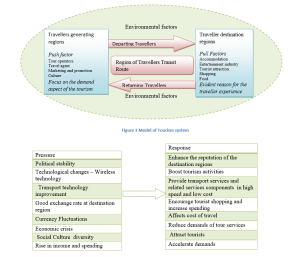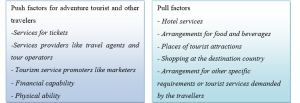TO5101 Adventure Tourism Assignment Sample
Here’s the best sample of TO5101 Adventure Tourism Assignment, written by the expert.
Introduction
The concept of ‘Tourism’ has transformed from exploring exotic and natural regions to a more adventurous form owing to the travellers changing travel preferences and increased interest in seeking adventure. The travellers now prefer in travelling to places for seeking adventurous experience and demands for activities that fulfil the sense of excitement requirement of outdoor activities, healthy and fitting activities combined with exploration (Buckley et al., 2014). The growth of thrill seeking travellers in travel market accelerated the growth of ‘Adventure Tourism’ but decelerated sight-seeing holiday and beachside vacation in the tourism industry.
Tourism Industry
The tourism is a fastest growing service industry that includes the individual travel or journey for business purpose and for leisure. This industry is dynamic and a major contributor to the country’s economy in terms of foreign currency reserves. The low cost airlines, rise in tourist travels to domestic and foreign places, increased preference for adventure are the major market growth drivers for the global tourism industry (Stará and Peterson, 2017). This has led to evolution of different form of tourism like adventure tourism. The adventure tourism industry has positively influence on different modes of transportation as adventure tourist requires different transport needs for caving, skydiving, mountain trekking, hiking and other adventurous activities.
Adventure Tourism
The adventure tourism industry forms the fastest growing niche in the tourism sector. Since 2009, the global adventure travel market has grown by 65 percent yearly rate (Adventure Travel News, 2013). Adventure tourism has established its strong place as outdoor tourism market due to increase in adventure tourist. The global adventure tourism industry accounts for $7.88 trillion revenue creation in 2015 and continue to grow at rate of 46b percent by 2020 (Australasian Leisure Management, 2017). Over the last few years, the concept of tourism has evolved to into different types of adventure tourism such as ecotourism, hard (high risk and physical effort) and soft (less physical effort) tourism which connect with nature, culture and physical activity (Mackenzie and Kerr, 2013). Adventure tourism comprises of combined activities that involve risk and demands physical effort from the participants for outdoor, sports and travel. The customers for this kind of tourism preference have distinct characteristics, activity preference, risk perception, travel behaviour and lifestyle (Rokenes et al., 2015). The demographic characteristics also play an important role to influence the decision to involve in adventure tourism activities such as packaged adventure holidays. For these activities, weather conditions play a significant role for tourism companies to provide travel wilderness and plan its sports and activities according to climate changes. Some adventure tourism winter activities are skiing, deep-sea diving, skating, snowboarding, sleigh rides, hiking and mountain biking. Some leading adventure tourism companies are the Blue Mountain resort (Ontario), Austin Adventures, East African Wilderness Travel, Explore Worldwide, Kensington Tours and many more in Europe, South America, Canada, Europe, Africa and Australia.
Leiper Model of Tourism

The tourist includes both nature travellers and adventure travellers along service providers or promoters such as tour operators and travel agents, food and beverages, tourism board and marketing in the model of tourism. The traveler-generating region (TGR) motivates the traveller for travel for leisure and adventure holiday packages (Darbellay and Stock, 2012). Here, the tourist search for information and plans the holiday makes reservation, check the financial and physical ability and book packages. The marketing and promotional activities by tourism service providers are an influencing factor for the departing tourists. These service providers are in direct contact with the travellers to provide destination information, travel –related requirements and services and other travel arrangements. The transit route region (TR) focuses on the modes of transport and communication for the short and long travel of the tourists. It includes transport services operators such as airline, railways, bus, car rental and cruise ship services. The planning and management of the tour plays a crucial role in tourist destination region (TDR) which embraces pull factors. The tourist destination region is the most evident factor for the traveller experience as it can impact on the future decision related to tours and travel.

STEP Analysis for Adventure Tourism
| Social Factors | The demographic characteristics such as age, lifestyles, risk taking attitudes, travel preferences are an important social factor that affects adventure tourism industry. The adventure tourist mostly includes travellers from the age group of 22 to 50. Another factor is society growing interest in healthy living and fitness activities will positively impact the future growth of this industry (Stará and Peterson, 2017). |
| Technological Factors | Technology development is a significant factor that impacts the success of the industry. Technological development is essential for adventure tourism companies to provide safety to participants and provide sound travel options to protect cultural and environment. Different equipments are used in outdoor adventure such as marine activities, hiking, etc and advance technologies GPS devices. |
| Economic Factors | Exchange rate fluctuations, recession, economic fluctuations -rise in income & spending (impacts demand), rise in instructor cost (impact companies operating cost), low travel cost are economic factors affecting the leisure and recreation aspects of this industry.
The adventure tourism and travel industry are responsible for GDP, economic activity and employment creation. The increase in amount spent per adventure travel is positively impacting the adventure tourism business and use of internet for booking travel packages. For instance, since 2009, the spending of European and American travellers has increased from $593 to $947 per trip in 2012 (Adventure Travel News, 2013). |
| Environmental Factors | Physical environment with presence of islands attracts tourists and weather conditions impact the planning of the companies for its sports, leisure and adventure activities according to climate changes.
High environmental pollution due to tourism travel. Tourism activities have a high impact on the environment in terms of biodiversity and natural resources, land degradation, and generation of waste. |
| Political Factors | Stable political structure of a country, industry regulations, visa policy, transport infrastructure, employment laws, environmental policies and certification for different activities are the major political factor influencing the adventure tourism. |
Conclusion
It can be summarised that the adventure tourism industry is progressing as a niche industry in a dynamic tourism industry. The social, economic, political and technological factors have a counter impact on the industry trends but providing ample of opportunity for growth and profitability of the adventure tourism industry.
References
Adventure Travel News. (2013) New Adventure Tourism Report Reveals $263B Market, Up 65% Per Annum Since 2009. [Online] Available at: https://www.adventuretravelnews.com/new-adventure-tourism-report-reveals-263b-market-up-65-per-annum-since-2009 (Accessed: 6 September 2017)
Australasian Leisure Management. (2017) Conference to explore US$7.88 trillion adventure tourism market. [Online] Available at: https://www.ausleisure.com.au/news/conference-to-explore-us7.88-trillion-adventure-travel-market/ (Accessed: 6 September 2017)
Buckley, R., Shakeela, A. and Guitart, D (2014) Adventure tourism and local livelihoods. Annals of Tourism Research, 48, pp. 269-272.
Darbellay, F. and Stock, M. (2012) Tourism as complex interdisciplinary research object. Annals of Tourism Research, 39(1), pp. 441-458.
Mackenzie, S. H. and Kerr, J. H. (2013) Stress and emotions at work: An adventure tourism guide’s experiences. Tourism Management, 36, pp. 3-14.
Rokenes, A., Schumann, S. and Rose, J. (2015) The art of guiding in nature-based adventure tourism–how guides can create client value and positive experiences on mountain bike and backcountry ski tours. Scandinavian Journal of Hospitality and Tourism, 15(1), pp. 62-82.
Stará, J. and Peterson, C. (2017) Understanding the Concept of Wellness for the Future of the Tourism Industry: A Literature Review. Journal of Tourism & Services, 8(14).
________________________________________________________________________________
Know more about UniqueSubmission’s other writing services:

